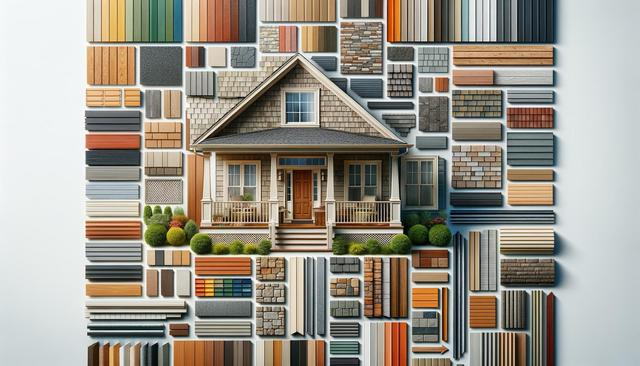
Understanding House Siding: A Guide to Materials, Costs, and Options
Popular Siding Materials and Their Characteristics
Choosing the right siding material is a significant decision for homeowners, as it directly affects both the appearance and performance of the home’s exterior. The most common siding materials include vinyl, fiber cement, wood, metal, and engineered wood. Each of these options offers unique benefits and limitations depending on the climate, maintenance preferences, and budget.
Vinyl siding is a widely used choice due to its affordability and low maintenance. It is available in a variety of colors and styles, often mimicking the appearance of wood. Fiber cement siding, on the other hand, is known for its durability and resistance to fire, insects, and rot. It’s a heavier material and may involve higher installation costs, but it offers a long lifespan. Wood siding remains a classic option, appreciated for its natural look and warmth, though it requires regular maintenance like staining or painting to avoid damage from moisture and pests.
Metal siding, including aluminum and steel, is another viable choice for modern or industrial-style homes. It’s resistant to fire and pests, though it can be prone to dents. Engineered wood siding combines wood fibers and resins to provide the appearance of real wood with enhanced durability. It’s often treated to resist moisture and decay, making it a practical alternative to traditional wood siding.
Costs Associated With Different Siding Options
The cost of siding varies greatly depending on the material, installation complexity, and the size of the home. While some materials are more budget-friendly upfront, others may offer better long-term value due to their durability and low maintenance requirements.
Here is a general cost breakdown for common siding types (including materials and installation):
- Vinyl siding: $3 to $7 per square foot
- Fiber cement siding: $5 to $10 per square foot
- Wood siding: $6 to $12 per square foot
- Metal siding: $5 to $10 per square foot
- Engineered wood siding: $4 to $9 per square foot
Keep in mind that these figures are averages and can fluctuate based on local labor rates, the condition of your existing exterior, and any additional features or customizations. Homeowners should also consider long-term costs such as maintenance, painting, or potential replacements when evaluating the total investment.
Factors to Consider When Choosing Siding
Beyond aesthetics, several practical factors should influence your siding decision. Climate is one of the biggest considerations. For example, fiber cement and metal siding perform well in areas with harsh weather, while wood siding may be better suited to milder environments where moisture is less of a concern.
Maintenance is another critical aspect. If you’re seeking a low-maintenance option, vinyl or metal siding may be more appealing. However, if your priority is a natural look and you’re willing to invest time in upkeep, wood siding could be the right fit. Additionally, sustainability and environmental impact are becoming increasingly important for many homeowners. Engineered wood and fiber cement often use recycled materials and are considered more eco-friendly choices.
Consider these factors when evaluating your siding options:
- Local climate and weather resistance
- Maintenance requirements and frequency
- Energy efficiency and insulation properties
- Environmental impact and recyclability
- Aesthetic preferences and neighborhood compatibility
Balancing these elements with your budget will help you choose siding that not only looks great but also performs well over time.
Energy Efficiency and Insulation Benefits
Siding does more than improve a home’s exterior—it also contributes to energy efficiency. Insulated siding helps regulate indoor temperatures, reducing the demand on heating and cooling systems. This can result in lower energy bills and a more comfortable living environment.
Some siding materials come with built-in insulation, such as insulated vinyl siding, which includes a layer of foam backing. Others, like fiber cement, can be paired with external insulation to boost their thermal performance. Metal and wood siding typically require additional insulation strategies to achieve similar energy-saving benefits.
Benefits of energy-efficient siding include:
- Reduced heating and cooling costs
- Improved indoor comfort year-round
- Potential eligibility for energy rebates or incentives
- Lower carbon footprint due to reduced energy consumption
When selecting siding, ask contractors about insulation options and how different materials compare in terms of R-value—the measure of thermal resistance. This helps ensure your siding not only enhances the exterior but also supports an energy-conscious lifestyle.
Installation and Long-Term Value
Proper installation is critical to maximizing the performance and lifespan of your siding. Even the highest-quality material can fail if installed incorrectly. That’s why it’s important to work with experienced professionals who understand the specific requirements of your chosen siding type.
In addition to installation quality, consider the long-term value your siding choice provides. Materials like fiber cement and engineered wood may have higher upfront costs but offer better longevity and lower maintenance. Meanwhile, vinyl siding, though more affordable, may require replacement sooner depending on exposure and quality.
To get the most value from your siding investment:
- Seek multiple quotes from licensed contractors
- Review warranties offered on both materials and labor
- Check for proper permits and code compliance
- Inspect existing walls for moisture damage before installation
Making an informed decision on siding involves looking beyond cost alone. Evaluate the durability, energy efficiency, maintenance, and appearance to ensure your home’s exterior remains attractive and functional for years to come.
Conclusion: Choosing the Right Siding for Your Home
House siding plays a vital role in protecting your home, enhancing its appearance, and improving energy efficiency. With various materials available, each offering distinct advantages and price points, homeowners have plenty of options to suit different needs and budgets. By understanding the characteristics and costs of each type, factoring in local climate, maintenance, and insulation potential, you can make a well-informed decision that adds both style and value to your home. Prioritize quality installation and consider long-term benefits to ensure your siding remains a smart investment for years to come.


